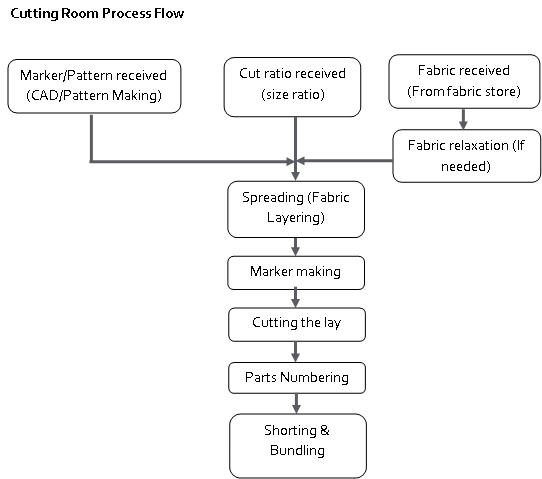Calculation of Fabric Utilization % in Cutting room
Apparel Manufacturing n Marketing
Fabric utilization:-
It means how much fabric is being
utilized in cutting for garment patterns out of total fabric laid for cutting.
Generally, fabric constitutes 60% to 70% of the total garment cost. So, through
effective fabric utilization factory can save lot of money from fabric.
Calculation of Fabric utilization:-
Step 1: Measure the lay length (A) that should be used in bulk cutting. And suppose fabric width is 1.2 meters. Collect the information of fabric GSM (Grams per square meter).
Step 2: Calculate weight of that lay (B).
Weight = Fabric width X Lay Length X GSM X No. of plies (You can also calculate taking multiple lays) or 1.2A*GSM * no. of plies
Step 3: Cut the patterns and collect all waste fabric and weigh waste. (C)
Step 4: Weight of the fabric of cut panels D = (B-C)
Step 1: Measure the lay length (A) that should be used in bulk cutting. And suppose fabric width is 1.2 meters. Collect the information of fabric GSM (Grams per square meter).
Step 2: Calculate weight of that lay (B).
Weight = Fabric width X Lay Length X GSM X No. of plies (You can also calculate taking multiple lays) or 1.2A*GSM * no. of plies
Step 3: Cut the patterns and collect all waste fabric and weigh waste. (C)
Step 4: Weight of the fabric of cut panels D = (B-C)
Step 5: Fabric utilization% = Weight of cut panels (D)/Total weight
of the lay (B)*100%
For the accuracy you can do this exercise with multiple lays and take average of them.
For the accuracy you can do this exercise with multiple lays and take average of them.
Example: For better understanding
following will be very helpful-
Step 1: Assume that
a) Measured lay length = 3 meters
b) Fabric GSM = 150
c) No. of Plies = 5 and
d) Fabric width = 1.2 meters,
Step 2: Calculated weight of the lay = 3*150*5*1.2 =2700 grams
Step 3: Weight of the collected waste after cutting = 300 grams
Step 1: Assume that
a) Measured lay length = 3 meters
b) Fabric GSM = 150
c) No. of Plies = 5 and
d) Fabric width = 1.2 meters,
Step 2: Calculated weight of the lay = 3*150*5*1.2 =2700 grams
Step 3: Weight of the collected waste after cutting = 300 grams
Step 4: Weight of the cut panels = (2700 – 300) = 2400 grams
Step 5: Fabric utilization percentage = (2400/2700*100) = 88.9%.
Step 5: Fabric utilization percentage = (2400/2700*100) = 88.9%.
If you have any comment about this post please put your
comment on below -
Thanks to Everyone...
